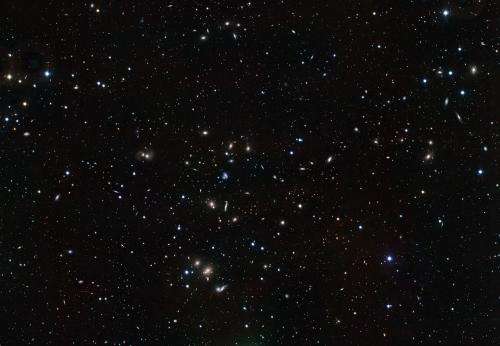VST captures collisions in young galaxy cluster

(PhysOrg.com) -- The VLT Survey Telescope (VST) at ESO’s Paranal Observatory in Chile has imaged a fascinating collection of interacting galaxies in the Hercules galaxy cluster. The sharpness of the new picture, and the hundreds of galaxies captured in great detail in less than three hours of observations, attest to the great power of the VST and its huge camera OmegaCAM to explore the nearby Universe.
The Hercules galaxy cluster (also known as Abell 2151) lies about 500 million light-years away in the constellation of Hercules. It is unlike other nearby galactic assemblies in many ways. As well as being rather irregular in shape, it contains a wide variety of galaxy types, particularly young, star-forming spiral galaxies, and there are no giant elliptical galaxies in sight.
The new image was taken with the VST, the most recent addition to ESO's Paranal Observatory in Chile. The VST is a survey telescope equipped with OmegaCAM, a 268-megapixel camera that provides images covering very large areas on the sky. Normally only small telescopes can image large objects such as this in a single shot, but the 2.6-metre VST not only has a wide field, but can also exploit the superb conditions on Paranal to simultaneously obtain very sharp and deep images quickly.
Galaxy pairs getting up close and personal and on their way to merging into single, larger galaxies can be seen all over this image. The numerous interactions, and the large number of gas-rich, star-forming spiral galaxies in the cluster, make the members of the Hercules cluster look like the young galaxies of the more distant Universe. Because of this similarity, astronomers believe that the Hercules galaxy cluster is a relatively young cluster. It is a vibrant and dynamic swarm of galaxies that will one day mature into one more similar to the older galaxy clusters that are more typical of our galactic neighbourhood.
Galaxy clusters are formed when smaller groups of galaxies come together due to the pull of their gravity. As these groups get closer to each other, the cluster becomes more compact and more spherical in shape. At the same time, the galaxies themselves get closer together and many start to interact. Even if spiral galaxies are dominant in the initial groups, the galactic collisions eventually distort their spiral structure and strip off their gas and dust, quenching most star formation. For this reason, most of the galaxies in a mature cluster are elliptical or irregular in shape. One or two large elliptical galaxies, formed from the merger of smaller galaxies and permeated by old stars, usually reside at the centres of these old clusters.
The Hercules galaxy cluster is believed to be a collection of at least three small clusters and groups of galaxies that are currently being assembled into a larger structure. Furthermore, the cluster itself is merging with other large clusters to form a galaxy supercluster. These giant collections of clusters are some of the largest structures in the Universe. The wide field of view and image quality of OmegaCAM on the VST make it ideal for studying the outskirts of galaxy clusters where the poorly-understood interactions between clusters are taking place.
This beautiful image shows not only the galaxies of the Hercules galaxy cluster, but also many faint and fuzzy objects in the background, which are galaxies that are much further away from us. Closer to home, several brilliant Milky Way stars are also visible in the foreground and there are even a few asteroids that have left short trails as they moved slowly across the image during the exposures.
Provided by ESO


















